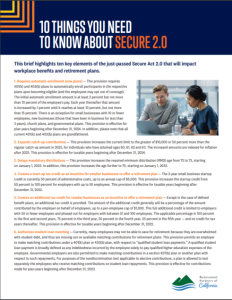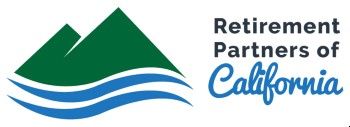There are 10 key elements of Secure Act 2.0 that will impact workplace benefits and retirement plans.
 #1 Requires automatic enrollment (new plans only)
#1 Requires automatic enrollment (new plans only)
— This provision requires 401(k) and 403(b) plans to automatically enroll participants in the respective plans upon becoming eligible (and the employees may opt out of coverage).
The initial automatic enrollment amount is at least 3 percent but not more than 10 percent of the employee’s pay. Each year thereafter that amount is increased by 1 percent until it reaches at least 10 percent, but not more than 15 percent. There is an exception for small businesses with 10 or fewer employees, new businesses (those that have been in business for less than 3 years), church plans, and governmental plans. This provision is effective for plan years beginning after December 31, 2024. In addition, please note that all current 401(k) and 403(b) plans are grandfathered.
#2 Expands catch-up contributions
This provision increases the current limit to the greater of $10,000 or 50 percent more than the regular catch-up amount in 2025, for individuals who have attained ages 60, 61, 62 and 63. The increased amounts are indexed for inflation after 2025. This provision is effective for taxable years beginning after December 31, 2024.
#3 Delays mandatory distributions
This provision increases the required minimum distribution (RMD) age from 72 to 73, starting on January 1, 2023. In addition, this provision increases the age further to 75, starting on January 1, 2033.
#4 Creates a start-up tax credit as an incentive for smaller businesses to offer a retirement plan
The 3-year small business startup credit is currently 50 percent of administrative costs, up to an annual cap of $5,000. This provision increases the startup credit from 50 percent to 100 percent for employers with up to 50 employees. This provision is effective for taxable years beginning after December 31, 2022.
#5 Creates an additional tax credit for smaller businesses as an incentive to offer a retirement plan
Except in the case of defined benefit plans, an additional tax credit is provided. The amount of the additional credit generally will be a percentage of the amount contributed by the employer on behalf of employees, up to a per-employee cap of $1,000. This full additional credit is limited to employers with 50 or fewer employees and phased out for employers with between 51 and 100 employees. The applicable percentage is 100 percent in the first and second years, 75 percent in the third year, 50 percent in the fourth year, 25 percent in the fifth year — and no credit for tax years thereafter. This provision is effective for taxable years beginning after December 31, 2022.
#6 Authorizes student-loan matching
Currently, many employees may not be able to save for retirement because they are overwhelmed with student debt, and thus are missing out on available matching contributions for retirement plans. This provision permits an employer to make matching contributions under a 401(k) plan or 403(b) plan, with respect to “qualified student loan payments.” A qualified student loan payment is broadly defined as any indebtedness incurred by the employee solely to pay qualified higher education expenses of the employee. Governmental employers are also permitted to make matching contributions in a section 457(b) plan or another plan with respect to such repayments. For purposes of the nondiscrimination test applicable to elective contributions, a plan is allowed to test separately the employees who receive matching contributions on student loan repayments. This provision is effective for contributions made for plan years beginning after December 31, 2023.
#7 Improves coverage for part-time workers
The SECURE Act currently requires employers to allow long-term, part-time workers to participate in the employers’ 401(k) plans. The SECURE Act provision provides that, except in the case of collectively bargained plans, employers maintaining a 401(k) plan must have a dual eligibility requirement under which an employee must complete either 1 year of service (with the 1,000-hour rule) or 3 consecutive years of service (where the employee completes at least 500 hours of service). This provision reduces the 3 year rule to 2 years, effective for plan years beginning after December 31, 2024. This provision also provides that pre-2021 service is disregarded for vesting purposes, just as such service is disregarded for eligibility purposes under current law, effective as if included in the SECURE Act to which the amendment relates. This provision also extends the long-term part-time coverage rules to 403(b) plans that are subject to ERISA.
#8 Allows Roth matching contributions
Plan sponsors now have the option to allow employees to elect to have some or all of their contributions be treated as after-tax Roth contributions (currently all matches are required to be pre-tax). This provision is effective immediately.
#9 Emergency savings accounts linked to individual retirement plan accounts
This provision allows employers to offer their non-highly compensated employees an emergency savings account that is linked to their workplace retirement account. Employers may automatically opt employees into these accounts at no more than 3 percent of their salary, and the portion of an account attributable to the employee’s contribution is capped at $2,500 (or lower as set by the employer). Once the cap is reached, the additional contributions can be directed to the employee’s Roth defined contribution plan (if they have one) or stopped until the balance attributable to contributions falls below the cap. Contributions are made on a Roth-like basis and are treated as elective deferrals for purposes of retirement matching contributions with an annual matching cap set at the maximum account balance ($2,500 or lower as set by the plan sponsor). The first four withdrawals from the account each plan year may not be subject to any fees or charges solely on the basis of such withdrawals. At separation from service, employees may take their emergency savings accounts as cash or roll it into their Roth defined contribution plan (if they have one) or IRA.
#10 Increases small-sum “force-out” option
Many plans adopt the small-sum force-out option which under current guidance allows distributions for terminated employees with a balance up to $5,000. This provision increases the amount to $7,000 and is effective for distributions made after December 31, 2023.
Retirement Partners Can Help
SECURE Act 2.0 is more comprehensive than what is outlined above, but these are some of the key areas of interest that could impact businesses. Retirement Partners of CA can be utilized to help your business take advantage of implementing and managing a retirement plan.
Disclosures, Sources, and Footnotes
For plan sponsor use only, not for use with participants or the general public. This information is not intended as authoritative guidance or tax or legal advice. You should consult with your attorney or tax advisor for guidance on your specific situation.
Approval 1-05365041








